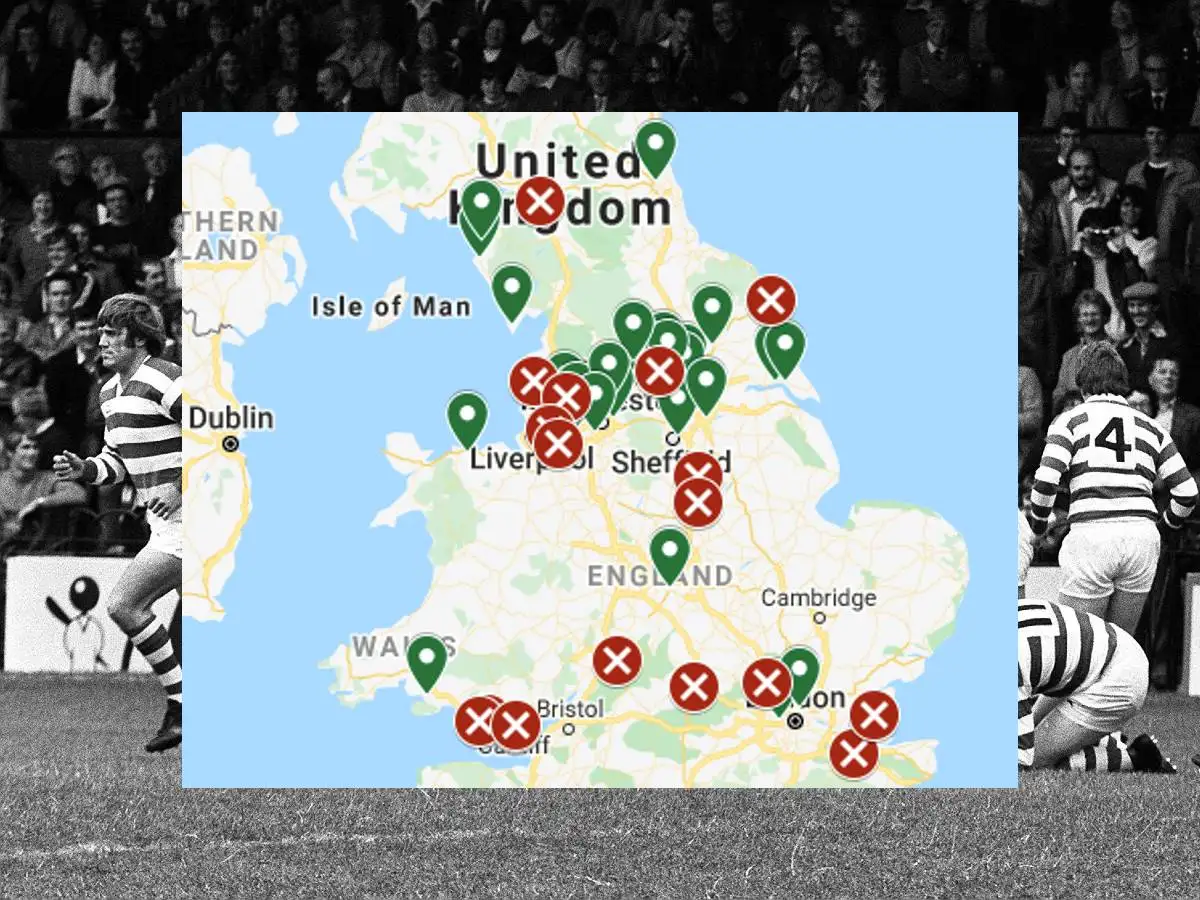40 years of pins in the professional rugby league map

It’s 40 years since London Broncos, or Fulham as they were known then, started an expansion trail that rugby league hasn’t quite cracked in the decades since.
Now in their second stint as the Broncos, Fulham became London Crusaders and Harlequins moving around a range of stadia in London.
They will play in the Championship in 2022 as a part-time outfit from AFC Wimbledon’s new Plough Lane ground.
A league below them will be rugby league’s latest trailblazers – Cornwall RLFC.
Another new destination
Cornwall was the UK destination chosen by Eric Perez, who had previously taken over Hemel Stags’ RFL membership and planned to take it to Ottawa.
With COVID, amongst other reasons, putting that to the sword, it is on the south west coast that League 1’s 11th team will be based.
There will be another refresh in expansion terms too – Coventry Bears have opted to rebrand to Midlands Hurricanes in an attempt to increase and no doubt accelerate their reach, as clubs in the third tier wrestle with substantial central funding cuts.
But can they succeed where others have failed, and finally give rugby league the established professional base it craves?
We look at all the clubs that have tried to take the game beyond its heartlands on the rugby league map in the last 40 years.

Back in 1980-81, Wigan were in the Second Division. There were 16 teams in the First Division and 15 in the Second.
Those 31 clubs were: Barrow, Batley, Blackpool, Bradford, Bramley, Castleford, Dewsbury, Doncaster, Featherstone, Fulham, Halifax, Huddersfield, Hull, Hull KR, Hunslet, Huyton, Keighley, Leeds, Leigh, Oldham, Rochdale, Salford, St Helens, Swinton, Wakefield, Warrington, Whitehaven, Widnes, Wigan, Workington, York
In 2022, there will be 37 clubs across three divisions. 28 of those were present in 1980/81*
(*on the basis that the new clubs in Bradford, Fulham and York are continuations of their predecessors).
Expansion timeline
Here is a timeline of when clubs have joined the professional structure in the past 40 years.
Season / Number of teams in professional structure / Info
| 1981/82 | 33 | ✅ Cardiff City Blue Dragons ✅ Carlisle |
| 1983/84 | 34 | ✅ Kent Invicta |
| 1984/85 | 36 | ✅ Mansfield Marksmen, ✅ Sheffield Eagles (Cardiff became Bridgend Blue Dragons, Kent became Southend Invicta, Huyton became Runcorn Highfield) |
| 1985/86 | 34 | ❌ Bridgend Blue Dragons ❌ Southend Invicta |
| 1987/88 | 34 | Blackpool became Springfield Borough |
| 1988/89 | 34 | Springfield became Chorley Borough |
| 1989/90 | 35 | ✅ Chorley Borough (old Chorley became Trafford Borough, Mansfield became Nottingham City) |
| 1991/92 | 36 | ✅ Scarborough Pirates (Runcorn became Highfield) |
| 1992/93 | 35 | ❌ Scarborough Pirates (Trafford became Blackpool Gladiators) |
| 1993/94 | 32 | ❌ Nottingham City, Blackpool Gladiators, Chorley Borough |
| 1995/96 | 33 | ✅ Chorley Chieftains |
| 1996 | 35 | ✅ Paris Saint Germain, ✅ South Wales (Highfield became Prescot Panthers) |
| 1997 | 34 | ✅ South Wales (Chorley became Lancashire Lynx) |
| 1998 | 31 | ❌ Paris ❌ Carlisle ❌ Prescot Panthers |
| 1999 | 32 | ✅ Gateshead |
| 2000 | 30 | ❌ Gateshead ❌ Bramley |
| 2001 | 31 | ✅ Gateshead (Lancashire became Chorley Lynx) |
| 2002 | 30 | ❌ York Wasps |
| 2003 | 32 | ✅ London Skolars ✅ York City Knights |
| 2006 | 34 | ✅ Blackpool Panthers ✅ Catalans Dragons ✅ Celtic Crusaders ❌ Chorley Lynx |
| 2009 | 35 | ✅ Toulouse |
| 2010 | 36 | ✅ South Wales Scorpions |
| 2011 | 35 | ❌ Blackpool |
| 2012 | 34 | ✅ North Wales Crusaders ❌ Crusaders ❌ Toulouse |
| 2013 | 37 | ✅ Hemel Stags ✅ Gloucestershire All Golds ✅ Oxford |
| 2014 | 38 | ✅ Coventry Bears |
| 2016 | 39 | ✅ Toulouse |
| 2017 | 38 | ✅ Toronto ❌ Oxford ❌ Gloucestershire All Golds (South Wales became West Wales Raiders) |
| 2019 | 37 | ❌ Hemel |
| 2020 | 36 | ❌ Toronto |
| 2022 | 37 | ✅ Cornwall |
A pattern seems to be frequent moves and rebrands, with very little time given to any of the new clubs to bed in a new area.
Of all the names above, Gateshead and Crusaders have fought back from the demise of their respective Super League franchises to remain established.
Other than that, only Catalans, London and latterly Toulouse have enjoyed some sustained presence and/or success.
Map of all professional clubs in UK since 1980
Here’s a map view of all the UK clubs (green markers are remaining clubs, red crosses are clubs who have since departed – *nearest locations are used where the ground used no longer exists)
In 2003, National League Three was created. There was no automatic promotion and relegation with National League Two, but the RFL hoped to introduce this in the future.
RUGBY LEAGUE MAP: Map of every rugby league club in the UK
The inaugural NL3 clubs were: Bradford Dudley Hill, Coventry Bears, Hemel Stags, Manchester Knights, Sheffield Hillsborough Hawks, South London Storm, St Albans Centurions, Teeside Steelers, Underbank Rangers, Warrington Wizards
Teams were later added in Birmingham, Bramley, Carlisle, Essex, Gateshead, Dewsbury and Featherstone.
For 2007, NL3 became the National Division of the Rugby League Conference.
A final word must go to the esteemed Phil Caplan of Forty-20.
The disingenuous '#rugbyleague goes national' narrative conveniently forgetting Plymouth NU, Ebbw Vale & a Welsh league, London Highfield, Kent Invicta, the Rugby League Conference et al; it's not the concept or ambition but the constant lack of strategy & resource surrounding it
— Phil Caplan (@scratchingshed2) November 3, 2021
Only time will tell if Cornwall and Midlands Hurricanes follow the path forged by the few rather than the many.
READ MORE: Has rugby league moved forward since 2004?



